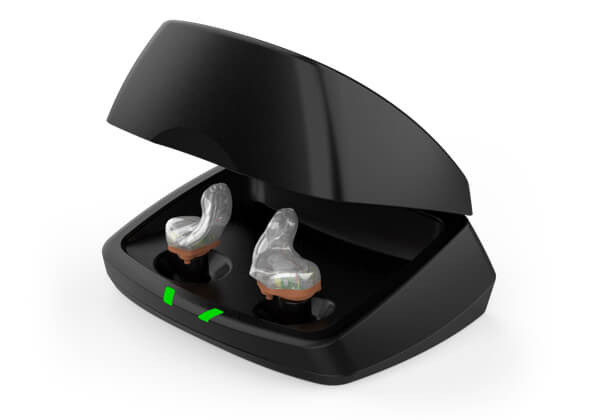
Rechargeable Hearing Aids
Hearing aids these days are powered by either one of two types of batteries. For the most part, disposable batteries are still the more common option, though more and more hearing aid manufacturers are making rechargeable devices that can be used with a charger or wall adapter.
With Americans buying nearly 180 tons of batteries each year, it makes sense for each of us to go rechargeable whenever possible. And that may include rechargeable hearing aids.
Batteries are a necessity in our modern world, but they take up so much space and cost so much money that many people turn away from them as soon as they can afford a new device. Just think about how often you have heard someone say “I’m going electronic” when discussing their transition to an e-cigarette. But what if we could do even more than just switch out one battery for another?
The focus of buying a hearing aid should be on the benefits of the instrument itself, not its features. Charging your battery every day is an inconvenience that can take away from your independence and quality of life. If you can get the same benefits with a product that doesn’t need to be recharged, then rechargeable is another advantage for those who prefer to go worry-free without constantly being tethered to a charger.
What is a rechargeable hearing aid?
The rechargeable batteries in your hearing aids can be used for a much longer period of time without the need to replace them. You will never have to worry about running out of juice with these babies.
Hearing aids with built-in batteries are really the way to go if you are not keen on changing out your hearing aid battery every few days or so. With this kind of product, all you need is a charging unit and you’re good to go.
Can I just switch out the batteries?
Switching to rechargeable hearing aid batteries can be a complicated process. You may not even know where to buy the batteries for your product, as most stores only carry button-sized cells that are not compatible with it.
Some hearing aids come equipped with rechargeable batteries, however some do not. If you’re looking for a more cost-effective option, talk to your healthcare professional about purchasing new hearing aids that are already equipped with rechargeable batteries. If not, there may be fewer choices available to you when it comes to the battery type and size.
Knowing the pros and cons rechargeable hearings aids can go a long way to help you. Our audiologists at Hearing Health Clinic can help pick the best style for you.
Advantages of using rechargeable batteries
Long shelf life – Current generations use lithium ion batteries, which can hold a charge for up to 30 hours and last approximately five years before you need to replace them.
Previous generations used nickel metal hydride batteries, which had a lifespan of about one year. Silver metal zinc batteries, known to be the first to power hearing aids— usually lasted for only six months before they needed to be replaced. On the other hand, hearing aids with disposable batteries need new batteries every few days to weeks, depending on the hearing aid model.
Safe for children – Disposable batteries are one of the most dangerous objects that can be found around a household. Since they are too small, it’s no surprise when a small child swallows them. Rechargeable batteries seem like they would pose the same risk, but fortunately they don’t! The only way someone could swallow an entire hearing aid is if they happen to swallow it whole.
Easier to handle – Rechargeable hearing instruments are a great option for people with dexterity issues or those who don’t want to worry about constantly buying new batteries. Because many of these types of hearing aids rely on small, disposable batteries that come in tiny packages, it can take time for some people to get the package open and insert their battery before it runs out of power. Rechargeable devices eliminate this problem by storing energy in an internal battery pack that just needs recharging when needed.
Disadvantages of rechargeable batteries
Lack of user control – In many rechargeable hearing aids, the battery is encased in the instrument and removing it yourself can be tricky. If you need to have your batteries replaced, there will probably be a down time where you don’t have your hearing aids at all. Even if you get a “loaner” temporarily, it won’t likely have the same settings as yours.
Dependency on a charging unit – if ever you forget to charge them or they stop working or one of the cords starts to fray there’s no easy way out, that could be a problem
Rechargeable Hearing Aids in Osseo, MN
Whichever angle we look at it, rechargeable hearing aids are here to stay and will continue to offer innovations in the hearing aid industry. If you’re in Minnesota and are looking for rechargeable hearing aids fitted by licensed audiologists, visit or call us at Hearing Health Clinic.
Curious about the latest hearing aid technology? Ask an audiologist for insights.

